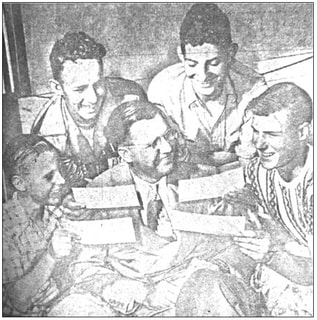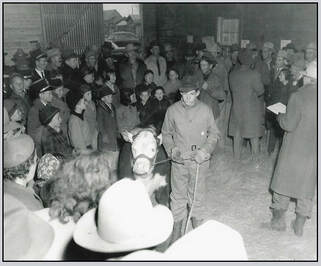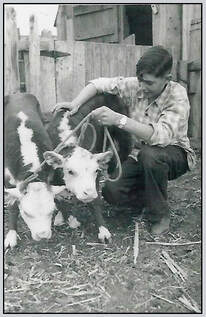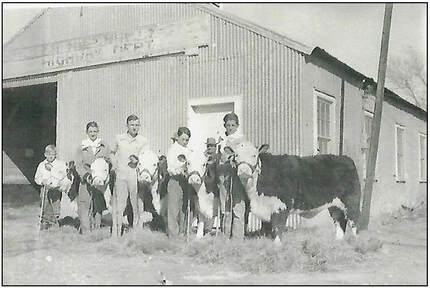4-H Programs Began in the 1930's

When J. B. Waide Jr. came to Moore County in 1937 as county agent, he found a county that had very limited assistance for any kind of agriculture programs, including 4-H programs.
There were no veterinarians, no vocational agriculture in schools and no soil conservation service. His responsibility was mostly in administering the Agricultural Adjustment Act, a program of the 1930's designed to help farmers get back on their feet after the depression and the dust bowl.
In an interview in the January 2, 1983 edition of the The Moore County News Press, Waide recalled, "They were about to write off Moore County as far as extension was concerned. The district director even told me that."
Waide was not willing to let that happen and worked with the new Home Demonstration Agent, Miss Marie Ludwick, to build agriculture and 4-H programs. She had come to Moore County as the first Home Demonstration Agent just a few months before Waide, so both were new to their jobs. Miss Ludwig commented once that her office was so new that the equipment consisted of a chair, a table that served as a desk and an orange crate that she used for a filing cabinet.
There were no veterinarians, no vocational agriculture in schools and no soil conservation service. His responsibility was mostly in administering the Agricultural Adjustment Act, a program of the 1930's designed to help farmers get back on their feet after the depression and the dust bowl.
In an interview in the January 2, 1983 edition of the The Moore County News Press, Waide recalled, "They were about to write off Moore County as far as extension was concerned. The district director even told me that."
Waide was not willing to let that happen and worked with the new Home Demonstration Agent, Miss Marie Ludwick, to build agriculture and 4-H programs. She had come to Moore County as the first Home Demonstration Agent just a few months before Waide, so both were new to their jobs. Miss Ludwig commented once that her office was so new that the equipment consisted of a chair, a table that served as a desk and an orange crate that she used for a filing cabinet.

The girl's 4-H program was headed by the Home Demonstration Agent in each county and the boy's program by the County Agent. "There really wasn't any 4-H program to speak of," recalled Waide.
4-H programs in the early days had one purpose -- to train young people to contribute to the family income.
Areas of interest were in field crops, gardens and livestock for the boys and sewing, canning and cooking for the girls. Most of the livestock training was geared toward cattle and swine, Waide pointed out, with some sheep-raising involved. "We bought the first registered Hampshire swine to the county too," added Waide.
The two leaders began contacting farm families to encourage participation in agricultural and 4-H activities. Waide credited the support of county judge Noel McDade and commissioners W. W. Burnett, Lew Haile, George Bain and Clyde Messenger for the rapid growth of the programs.
4-H programs in the early days had one purpose -- to train young people to contribute to the family income.
Areas of interest were in field crops, gardens and livestock for the boys and sewing, canning and cooking for the girls. Most of the livestock training was geared toward cattle and swine, Waide pointed out, with some sheep-raising involved. "We bought the first registered Hampshire swine to the county too," added Waide.
The two leaders began contacting farm families to encourage participation in agricultural and 4-H activities. Waide credited the support of county judge Noel McDade and commissioners W. W. Burnett, Lew Haile, George Bain and Clyde Messenger for the rapid growth of the programs.
 4-H judging, late 1940's
4-H judging, late 1940's
In the 1983 article, Waide recalled the first livestock sale was conducted with the 4-H show. "We had always sent the livestock to the Amarillo show and sale, but they got so they didn't want anything but the champions. We only had four or five animals to sell and W. R. Rutherford was auctioneer and O. B. Thomas was the ring man."
"The show had no permanent home and was held outside in January. When the county built a barn over by the railroad, we could have show indoors," recalled Waide.
Today the show is held in the Community Building at 16th and Maddox.
4-Her's are participating in a large variety of events -- from dress revues to cooking contests, from demonstrations to raising livestock. They learn about gardening, photography, arts and crafts, citizenship, computers, shooting sports, pet care and training and many other ways to grow life skills.
"The show had no permanent home and was held outside in January. When the county built a barn over by the railroad, we could have show indoors," recalled Waide.
Today the show is held in the Community Building at 16th and Maddox.
4-Her's are participating in a large variety of events -- from dress revues to cooking contests, from demonstrations to raising livestock. They learn about gardening, photography, arts and crafts, citizenship, computers, shooting sports, pet care and training and many other ways to grow life skills.
 Billy Piehl with his 4-H project, late 1940's
Billy Piehl with his 4-H project, late 1940's
The program is the largest youth development program in Texas, reaching about 550,000 youth a year.
In 1949, Waide and four boys from a 4-H club project raised a small herd of cattle, then took them to the cattle market in Oklahoma City to sell. The four boys, Neil Messenger, Charles Sheldon Jr., Billy Piehl and Eddie Stallwitz shared the profits from the project.
Other young people have gotten their start in their careers from projects they did in 4-H.
Waide served as County Agent for Moore County until 1950. Miss Ludwig served until 1941 when she resigned to marry Ed Stallwitz.
In 1949, Waide and four boys from a 4-H club project raised a small herd of cattle, then took them to the cattle market in Oklahoma City to sell. The four boys, Neil Messenger, Charles Sheldon Jr., Billy Piehl and Eddie Stallwitz shared the profits from the project.
Other young people have gotten their start in their careers from projects they did in 4-H.
Waide served as County Agent for Moore County until 1950. Miss Ludwig served until 1941 when she resigned to marry Ed Stallwitz.
